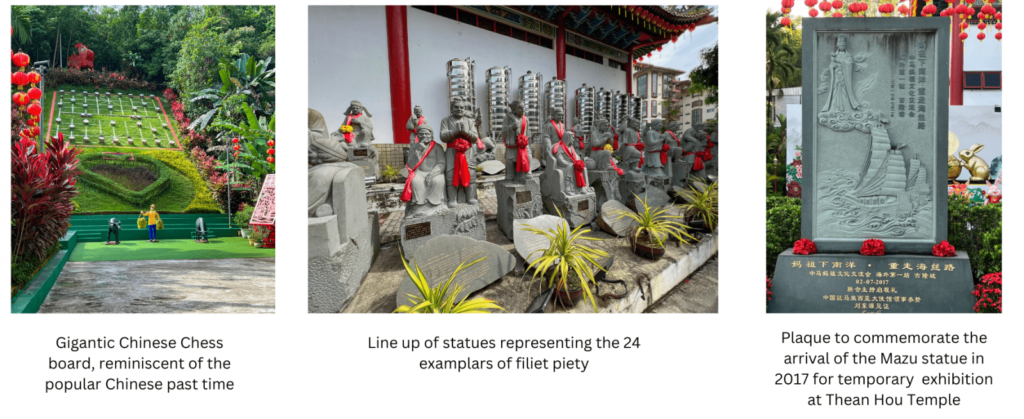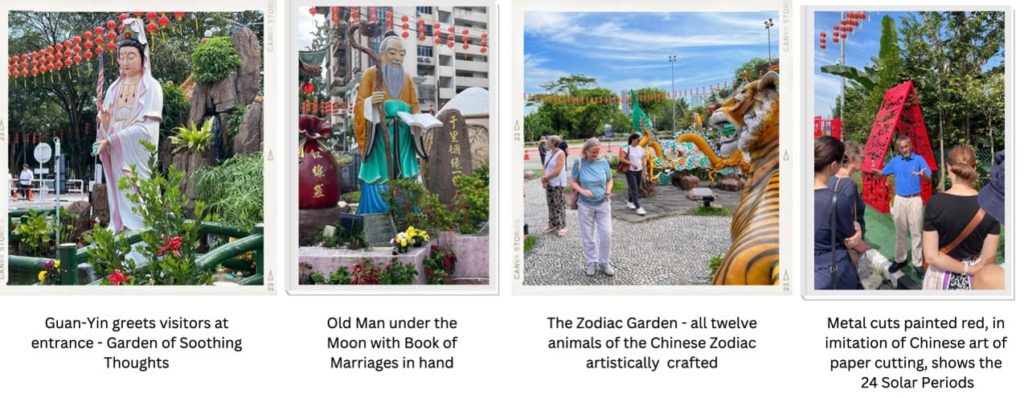MCG Explorers’ Explore Thean Hou Temple
Date February 2023
Duration 10a.m. – 12.30p.m.
Participants 14 Members
Convenor and Guide Tajuddin Idrus
Sitting atop Robson Heights with a commanding view of the Syed Putra neighbourhood in Kuala Lumpur, is the Thean Hou Temple.
Construction began in 1981 and officially opened in 1989, it is dedicated to Mazu, revered as Goddess of the Ocean and patron of seafarers, sailors and fishermen. Thean Hou or Tian Fei are among her many titles, but ‘Mazu’ which loosely translates into ‘Holy Grandmother is favoured by the various communities which have dedicated temples in her honour as acts of gratitude for her protection during dangerous voyages and journeys across the seas.
This imposing temple is an object of gratitude and devotion of the Hainanese community of Selangor and Federal Territory of Kuala Lumpur (Persatuan Hainan Selangor & WP) who migrated to Malaya in the early 20th century, and their descendants. From humble beginnings as cooks, some to the colonial masters, the early immigrants from the island of Hainan in southern China, have made a name for their culinary skills adding new condiments and sauces to their ethnic and local Chinese dishes to suit the ‘foreign’ palate. Many of us still enjoy ‘chicken chop’, a dish (for the British) concocted and made popular by Hainanese cooks.
Temple architecture of north and south China are incorporated in this hybrid structure, a bold enterprise undertaken by the Malaysian Hainanese community. Tajuddin, MCG Explorers Convenor who was guide for the day, pointed out the roof styles of south and north China – the swallow tail and the horizontal with single and double eaves. The celestial animals on the roof rafters have significance from the rich tapestry of Chinese folklore – the mythical qilin, dragon, tortoise and phoenix. Symbols from Chinese cosmology are also evident, both for ornamentation and for the auspicious aspects they signify.
The popularity of Thean Hou Temple is attributed to the representation of the three doctrines of Buddhism, Taoism and Confucianism within the premise. Features of these doctrines are depicted in the gardens, landscaping, prayer and worship halls. The beautiful balustrades and decorative beams are visible from the outside while murals, calligraphic couplets, column beams and domed ceiling of the main hall add to the beauty of the edifice.
The incorporation of features of the Three Doctrines makes this temple an example of tolerance in worship. Worshippers identify with the doctrines – meditation with Buddhism, joss sticks with Taoism and filial piety with Confucianism.


In the main hall is installed the Heavenly Mother or Mazu (Holy Grandmother), seated on a throne. Regal with her headgear and veil, she looks with love to those who come to respect and worship her. On her left is Guan-Yin, The Goddess of Mercy and in the niche on the other side is the Goddess of the Waterfront, another deity revered by the Hainanese.
In this main hall, those who wish to seek solace and solution to problems or wish to have a peek into what is in store for them may do so at the oracle stands here. Just lift the whole bundle of numbered oracle sticks with both hands and then drop them back into the container. The last one in is the stick with the answer to the request. Next, take the answer slip from the drawer with the corresponding number on the stick. Some members tried it and only they can testify to its accuracy!
Kuan Ti, God of War, also has a place in this temple. Deified by emperors and people for his military prowess during the Three Kingdoms period, his veneration has spread even to this part of the world.
There was much to see, learn and appreciate during the temple tour and we commend Tajuddin for being such a great guide and photographer. His knowledge and wit made the visit worthwhile.
Review by Siew Yen
